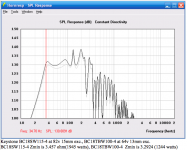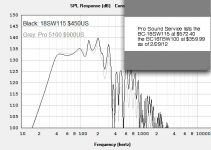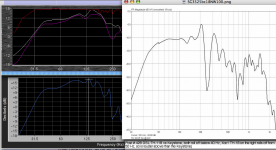Hi Martin,
I think there are two problems with your model:
1. The air in the horn is not running like a 'flow' but the air molecules bounce against each other.
2. There are no pressure points after the throat in an expanding horn.
When the frequency drops below the excursion dip in your picture, the right side of the driver becomes unloaded first (distance versus frequency). Therefore I prefer centre loadings with a (cone)volume make up.
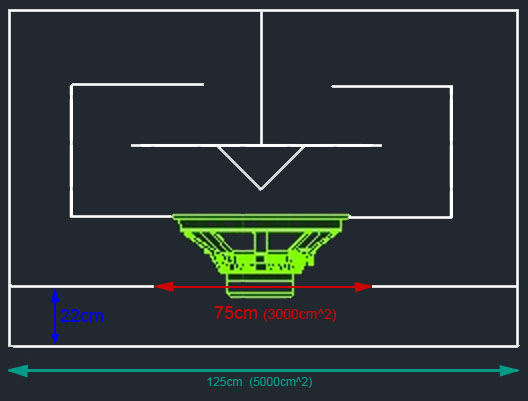
Since this is not always possible another way is to close half of the throat (the half on the left side in your picture) so that the soundwaves from the cone all have the same distance to S2.

The 'S' form is needed to follow the curve of the cone and dome of the driver.
This way the S2 becomes again the centre point of pressure and both sides of the driver are more equally loaded.
I think there are two problems with your model:
1. The air in the horn is not running like a 'flow' but the air molecules bounce against each other.
2. There are no pressure points after the throat in an expanding horn.
When the frequency drops below the excursion dip in your picture, the right side of the driver becomes unloaded first (distance versus frequency). Therefore I prefer centre loadings with a (cone)volume make up.

Since this is not always possible another way is to close half of the throat (the half on the left side in your picture) so that the soundwaves from the cone all have the same distance to S2.

The 'S' form is needed to follow the curve of the cone and dome of the driver.
This way the S2 becomes again the centre point of pressure and both sides of the driver are more equally loaded.
Last edited:
Hi Djim
Thats an interesting solution.
An obstruction like that would have to be offset from the baffle plate to miss the driver excursion, which could be quite a distance, given the X mech of some of the drivers available.
I have never seem that used in a DIY TH speaker. Do you know of any practical examples?
I like that you have taken account of the shape of the cone.
The cone shape must make quite a difference to the cross sectional area of the throat, as the air molecules bounce into each other across the offset face of the speaker.
Regards Martin
Thats an interesting solution.
An obstruction like that would have to be offset from the baffle plate to miss the driver excursion, which could be quite a distance, given the X mech of some of the drivers available.
I have never seem that used in a DIY TH speaker. Do you know of any practical examples?
I like that you have taken account of the shape of the cone.
The cone shape must make quite a difference to the cross sectional area of the throat, as the air molecules bounce into each other across the offset face of the speaker.
Regards Martin
I don't doubt you djim, but if the shape made that much of a difference to the cone, why aren't people destroying drivers due to uneven pressure on the cone in every TH that doesn't have the S-shaped covering? Is it because the compression ratio is low enough And the cones are stiff enough to resist deformation?
Hi Martin,
I think it was djk who showed an actual picture of an existing example in some thread. It reminded me of its true function since it is an old trick used by several companies in the past (maybe also today, I don’t know) for 'problem' horns in a time that cones were not enforced with fibres or other exotic materials.
When the throat isn’t optimal loaded, which is the case in most horns and TH’s (I mean different speeds of particles along the throat line) it can end in complex behaviour at max excursion.
About its optimum form, with your advanced 3D modelling skills you should be able to optimise it in relation to the form of the cone/dome. If it is the answer for all mechanical problems at high excursion I don't know yet.
Hi mRgSr,
I don’t have all the answers, but the stability of the mechanical characteristics are very important to drivers that have to operate around their max excursion. You have experienced that difference in quality yourself
I think it was djk who showed an actual picture of an existing example in some thread. It reminded me of its true function since it is an old trick used by several companies in the past (maybe also today, I don’t know) for 'problem' horns in a time that cones were not enforced with fibres or other exotic materials.
When the throat isn’t optimal loaded, which is the case in most horns and TH’s (I mean different speeds of particles along the throat line) it can end in complex behaviour at max excursion.
About its optimum form, with your advanced 3D modelling skills you should be able to optimise it in relation to the form of the cone/dome. If it is the answer for all mechanical problems at high excursion I don't know yet.
Hi mRgSr,
I don’t have all the answers, but the stability of the mechanical characteristics are very important to drivers that have to operate around their max excursion. You have experienced that difference in quality yourself
Last edited:
this picture looks like the Cyclops cabinet.Hi Martin,
I think there are two problems with your model:
1. The air in the horn is not running like a 'flow' but the air molecules bounce against each other.
2. There are no pressure points after the throat in an expanding horn.
When the frequency drops below the excursion dip in your picture, the right side of the driver becomes unloaded first (distance versus frequency). Therefore I prefer centre loadings with a (cone)volume make up.
An externally hosted image should be here but it was not working when we last tested it.
.
Hi Martin,
Danley seems to use another approach. Some owners describe the Danley throats as having a "V" shape. Such "V" shape has two advantages:
1.) The "V" shape opening is closing towards the end of the driver probably to equalise the pressure.
2.) The second advantage of the "V" shape seems to be that the horn length from S1 to S2 is at least 3 times the diameter of the driver. By positioning the driver more away from S1, the pressure/loading differences between the two sides of the cone becomes smaller.
(The picture is meant as an example of the principle and is not a realistic representation of any Danley's TH's)
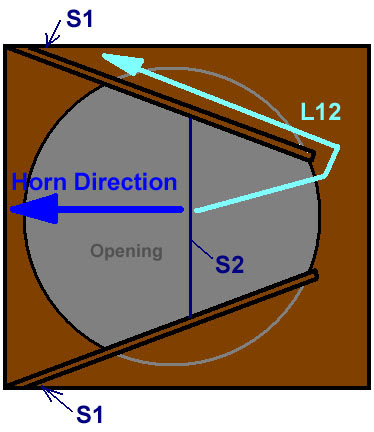
Danley seems to use another approach. Some owners describe the Danley throats as having a "V" shape. Such "V" shape has two advantages:
1.) The "V" shape opening is closing towards the end of the driver probably to equalise the pressure.
2.) The second advantage of the "V" shape seems to be that the horn length from S1 to S2 is at least 3 times the diameter of the driver. By positioning the driver more away from S1, the pressure/loading differences between the two sides of the cone becomes smaller.
(The picture is meant as an example of the principle and is not a realistic representation of any Danley's TH's)

Last edited:
Without performing an A/B test, hard to say.so with Xco1's T18 here, should the baffle have this shape?
PASC did mention the Keystone TH design had better cone control than the TH18 design using the same speaker, perhaps you could ask him to try the shaped plate and see if it helps.
Or DIY
Art
Without performing an A/B test, hard to say.
PASC did mention the Keystone TH design had better cone control than the TH18 design using the same speaker, perhaps you could ask him to try the shaped plate and see if it helps.
Or DIY.
Art
@Scameron: or at least build the plate and ship it to him to test
Keystone TH compatability
Aloha everybody.
I got a question for Art.
First of all.
Thank you for sharing your knowledge and experience with us.
I'm looking for home bass solution in 35-90hz range.
Will the JBL LE14A or JBL 2235H work in the Keystone TH?
I tried Martinson TH15, it didn't work with them. Seems like a sound is choking inside the cabinet.
thank you.
Aloha everybody.
I got a question for Art.
First of all.
Thank you for sharing your knowledge and experience with us.
I'm looking for home bass solution in 35-90hz range.
Will the JBL LE14A or JBL 2235H work in the Keystone TH?
I tried Martinson TH15, it didn't work with them. Seems like a sound is choking inside the cabinet.
thank you.
Without performing an A/B test, hard to say.
PASC did mention the Keystone TH design had better cone control than the TH18 design using the same speaker, perhaps you could ask him to try the shaped plate and see if it helps.
Or DIY.
Art
Sergey,Aloha everybody.
I got a question for Art.
First of all.
Thank you for sharing your knowledge and experience with us.
I'm looking for home bass solution in 35-90hz range.
Will the JBL LE14A or JBL 2235H work in the Keystone TH?
I tried Martinson TH15, it didn't work with them. Seems like a sound is choking inside the cabinet.
thank you.
Although every speaker put in the Keystone "worked", work is a relative term. The Eminence 4015LF had decent frequency response, but the relatively lightweight cone, fine in a ported cabinet, distorted badly when pushed to Xmax in the tapped horn. Sims don't show distortion.
The JBL cones you ask about would probably fare little better (and possibly worse) than the 4015LF.
The LE14A only has an Xmax of 5.08mm, the 2235H is only 8.38mm.
The B&C18SW115 has an Xmax of around 15, three times the former, and almost double the latter.
Doubling Xmax allows for about 6 dB more output.
B&C now has a new cheaper (heavier slab magnet) driver, the 18TBW100 (4 or 8 ohm) with similar specs to the 18SW115.
It models well in both XOC1's TH-18 or the Keystone, though in the Keystone it can take more power before exceeding Xmax, and put out a bit more level.
Art
Last edited:
Sergey,
B&C now has a new cheaper (heavier slab magnet) driver, the 18TBW100 (4 or 8 ohm) with similar specs to the 18SW115.
It models well in both XOC1's TH-18 or the Keystone, though in the Keystone it can take more power before exceeding Xmax, and put out a bit more level.
Art
Have you guys posted those numbers anywhere?
Keystone TH compatability
thank you Art.
thank you Art.
Sergey,
Although every speaker put in the Keystone "worked", work is a relative term. The Eminence 4015LF had decent frequency response, but the relatively lightweight cone, fine in a ported cabinet, distorted badly when pushed to Xmax in the tapped horn. Sims don't show distortion.
The JBL cones you ask about would probably fare little better (and possibly worse) than the 4015LF.
The LE14A only has an Xmax of 5.08mm, the 2235H is only 8.38mm.
The B&C18SW115 has an Xmax of around 15, three times the former, and almost double the latter.
Doubling Xmax allows for about 6 dB more output.
B&C now has a new cheaper (heavier slab magnet) driver, the 18TBW100 (4 or 8 ohm) with similar specs to the 18SW115.
It models well in both XOC1's TH-18 or the Keystone, though in the Keystone it can take more power before exceeding Xmax, and put out a bit more level.
Art
tundraLTD in post #3 of this wrote:Have you guys posted those numbers anywhere?
http://www.diyaudio.com/forums/subwoofers/207771-new-lower-cost-b-c-18-a.html
“Just plugged it into my Akabak script of the TH-18 Flat to 35hz! (Xoc1's design)
It sims great hitting Xmax at just over 900w. I may have to order a few! Thanks for the find.”
The Xoc1 TH-18 as built rolls off below 50 Hz, the Keystone (like the Danley TH-118) rolls off below 40 Hz, closer to "Flat to 35Hz!"
The higher LF knee of the Xoc1 TH-18 allows it to play louder higher, but excursion goes up below Fb, so it can’t take as much power without sounding, a bit distressed.
The sim’s below show very little difference in output at Xmax for the new BC18TBW100 and the BC18SW115.
The BC18TBW100 has an Xmech (where mechanical damage will occur) of 28.5mm, Hornresp says it would take 138 volts (5874 watts in the Keystone sim) to reach that, and it would hit over 135 dB.
In real life with music, thermal compression and the stiff compliance would probably not allow hitting Xmech and long term power of around 6000 watts would probably smoke the driver, but the BC18SW115-4 has no problem with 120 volt peaks, I expect the BC18TBW100-4 would not either.
Art
Attachments
Hi Art,The higher LF knee of the Xoc1 TH-18 allows it to play louder higher, but excursion goes up below Fb, so it can’t take as much power without sounding, a bit distressed.
If cut with >24dB/oct at 37Hz, drivers in the Xoc1 can handle their AES power ratings.
The 18TBW100 with a 12dB Butterworth highpass @ 32Hz will do 900+watts. With a L/R 12dB highpass 1600+watts. Akabak sims show nearly NO difference in SPL output so why would you push it that much harder?
An externally hosted image should be here but it was not working when we last tested it.
- Home
- Loudspeakers
- Subwoofers
- TH-18 Flat to 35hz! (Xoc1's design)

